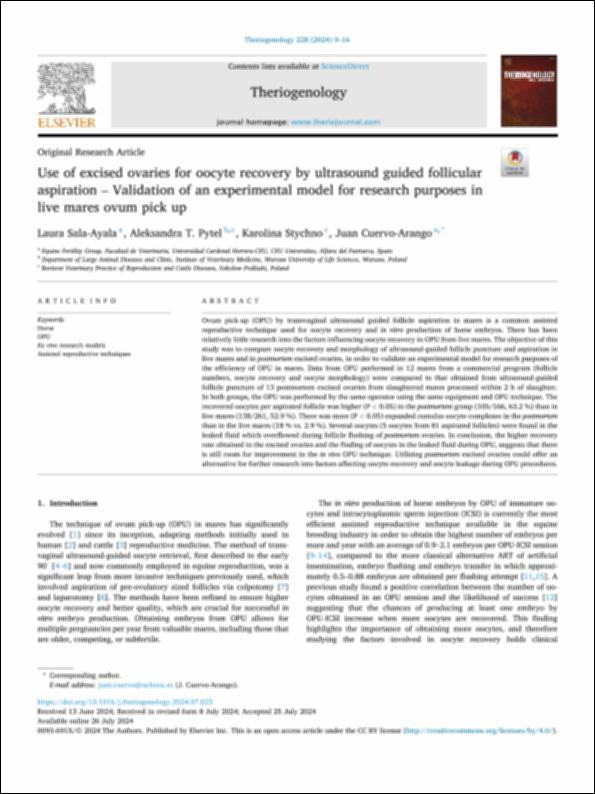Por favor, use este identificador para citar o enlazar este ítem:
http://hdl.handle.net/10637/16113Use of excised ovaries for oocyte recovery by ultrasound guided follicular aspiration – Validation of an experimental model for research purposes in live mares ovum pick up
| Título : | Use of excised ovaries for oocyte recovery by ultrasound guided follicular aspiration – Validation of an experimental model for research purposes in live mares ovum pick up |
| Autor : | Sala Ayala, Laura Pytel, Aleksandra T. Stychno, Karolina Cuervo-Arango Lecina, Juan |
| Materias: | Caballos; Horses; Reproducción animal; Animal reproduction; Reproducción artificial; Artificial reproduction |
| Editorial : | Elsevier |
| Citación : | Sala Ayala, L., Pytel, A.T., Stychno, K. & Cuervo-Arango, J. (2024). Use of excised ovaries for oocyte recovery by ultrasound guided follicular aspiration – Validation of an experimental model for research purposes in live mares ovum pick up. Theriogenology, vol. 228 (oct.), pp. 9-16. DOI: https://doi.org/10.1016/j.theriogenology.2024.07.023 |
| Resumen : | Ovum pick-up (OPU) by transvaginal ultrasound guided follicle aspiration in mares is a common assisted reproductive technique used for oocyte recovery and in vitro production of horse embryos. There has been relatively little research into the factors influencing oocyte recovery in OPU from live mares. The objective of this study was to compare oocyte recovery and morphology of ultrasound-guided follicle puncture and aspiration in live mares and in postmortem excised ovaries, in order to validate an experimental model for research purposes of the efficiency of OPU in mares. Data from OPU performed in 12 mares from a commercial program (follicle numbers, oocyte recovery and oocyte morphology) were compared to that obtained from ultrasound-guided follicle puncture of 13 postmortem excised ovaries from slaughtered mares processed within 2 h of slaughter. In both groups, the OPU was performed by the same operator using the same equipment and OPU technique. The recovered oocytes per aspirated follicle was higher (P < 0.05) in the postmortem group (105/166, 63.2 %) than in live mares (138/261, 52.9 %). There was more (P < 0.05) expanded cumulus oocyte complexes in the postmortem than in the live mares (18 % vs. 2.9 %). Several oocytes (5 oocytes from 81 aspirated follicles) were found in the leaked fluid which overflowed during follicle flushing of postmortem ovaries. In conclusion, the higher recovery rate obtained in the excised ovaries and the finding of oocytes in the leaked fluid during OPU, suggests that there is still room for improvement in the in vivo OPU technique. Utilizing postmortem excised ovaries could offer an alternative for further research into factors affecting oocyte recovery and oocyte leakage during OPU procedures. |
| URI : | http://hdl.handle.net/10637/16113 |
| Derechos: | http://creativecommons.org/licenses/by/4.0/deed.es Open Access |
| ISSN : | 0093-691X 1879-3231 (Electrónico) |
| Cubierto por: | Acuerdo Transformativo – 2024 |
| Fecha de publicación : | oct-2024 |
| Centro : | Universidad Cardenal Herrera-CEU |
| Aparece en las colecciones: | Dpto. Medicina y Cirugía Animal |
Los ítems de DSpace están protegidos por copyright, con todos los derechos reservados, a menos que se indique lo contrario.


